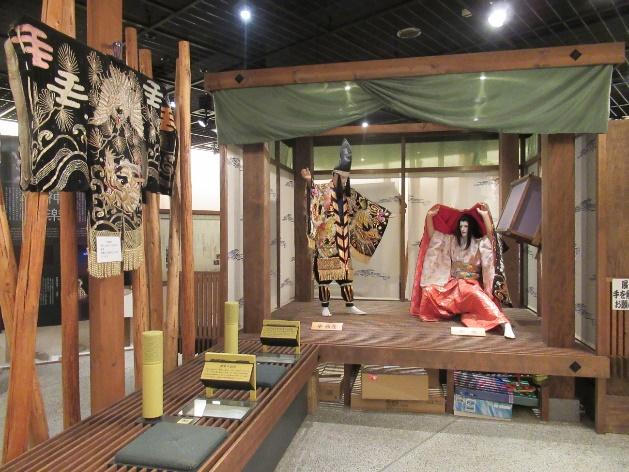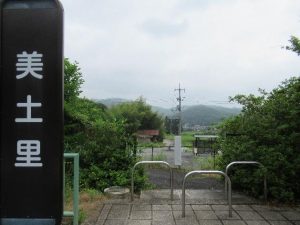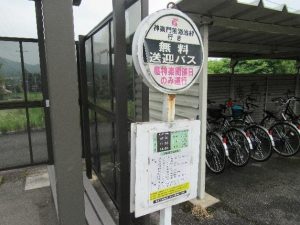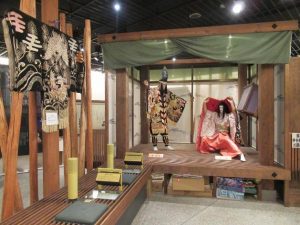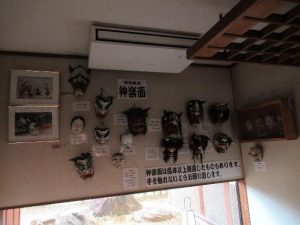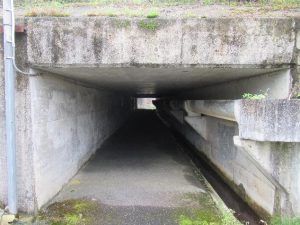100 Stories
Kagura Village: Showing Plays Year-Round in Akitakata
Traditional entertainment in Japan is closely tied to Shintoism, a religion native to Japan. Kagura was a form of ritual dance that was believed to have to power to summon gods, Noh plays were often performed at shrines, and even sumo wrestling was originally intended to be entertainment for the Shinto gods. Today, Hiroshima continues to be a base for numerous kagura troupes, who most often perform in the autumn, when numerous festivals take place. The performances are held in the vicinity of a shrine, and since food stalls are also nearby, guests tend to buy and bring festival food to eat while watching the plays. In the heart of the city within the walls of the Former Bank of Japan Hiroshima Branch, there are several times throughout the fall where patrons can catch a free glimpse of yokagura (night kagura).

However, if you are not in Japan in the autumn, fret not, for there is a place where visitors can watch kagura at any time of the year called Kaguramonzen Tojimura, located in Akitakata City, not too far north of Hiroshima City. Kaguramonzen Tojimura is a countryside resort area with an old-timey village feel to it, where guests watch kagura (on Fridays, Saturdays, and Sundays), bathe in the hot springs, gorge on spreads made with ingredients brought straight from the mountains, and spend the night relaxing far away from the chaotic city. From the Hiroshima Bus Center, take a bus bound for Miyoshi and get off at a stop called 美土里 (みどり – Midori), on the side of a highway. Upon getting off, head down the slope to another bus stop inhabited with friendly spiders, where a free shuttle bus will take you to the village. Do note, though, that this shuttle bus typically only runs on Sundays, so if you decide to visit on any other day, you will have to phone in to make a reservation (in Japanese).
Village Grounds
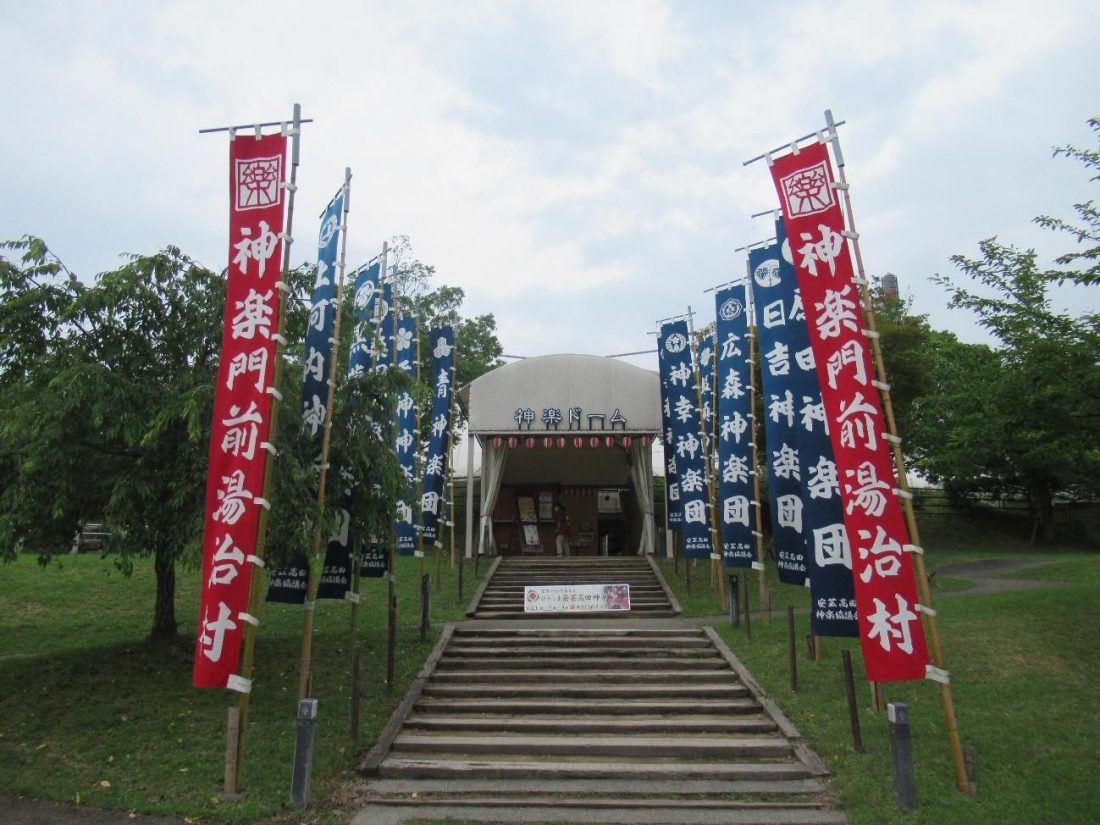
The fun begins once you’ve reached the village, even before the show starts. I walked through the village, admiring the Showa-era storefronts selling nostalgic toys, snacks, homemade tofu, and hot, fresh bread. At the western end of the village site is the Kagura Dome, where today’s performances were to be held. I bought my ticket ahead of time and turned back around to continue my exploration. In addition to stores and restaurants, Kaguramonzen Tojimura also touts hot springs, a workshop where visitors can engage in hands-on experiences, and a small kagura museum.
Upon entering the kagura museum, visitors are met with a gift shop selling local handicrafts and toys modeled after kagura props, such as swords, axes, polearms, and bows with arrows. The exhibition room features information pertaining to the history and geography of kagura, as well as mannequins in costume and old props used in the performances of yesteryear. Outside the exhibition room down the hall, they had a limited time display on the wall starring masks from the past dating over a century. Next to that was a kagura theater, a room significantly smaller than the Kagura Dome where yokagura is performed. On Friday and Saturday nights, guests staying overnight would watch the shows here, but on Sunday afternoon (presumably when more guests are making day trips here), the performances are held in the larger Kagura Dome.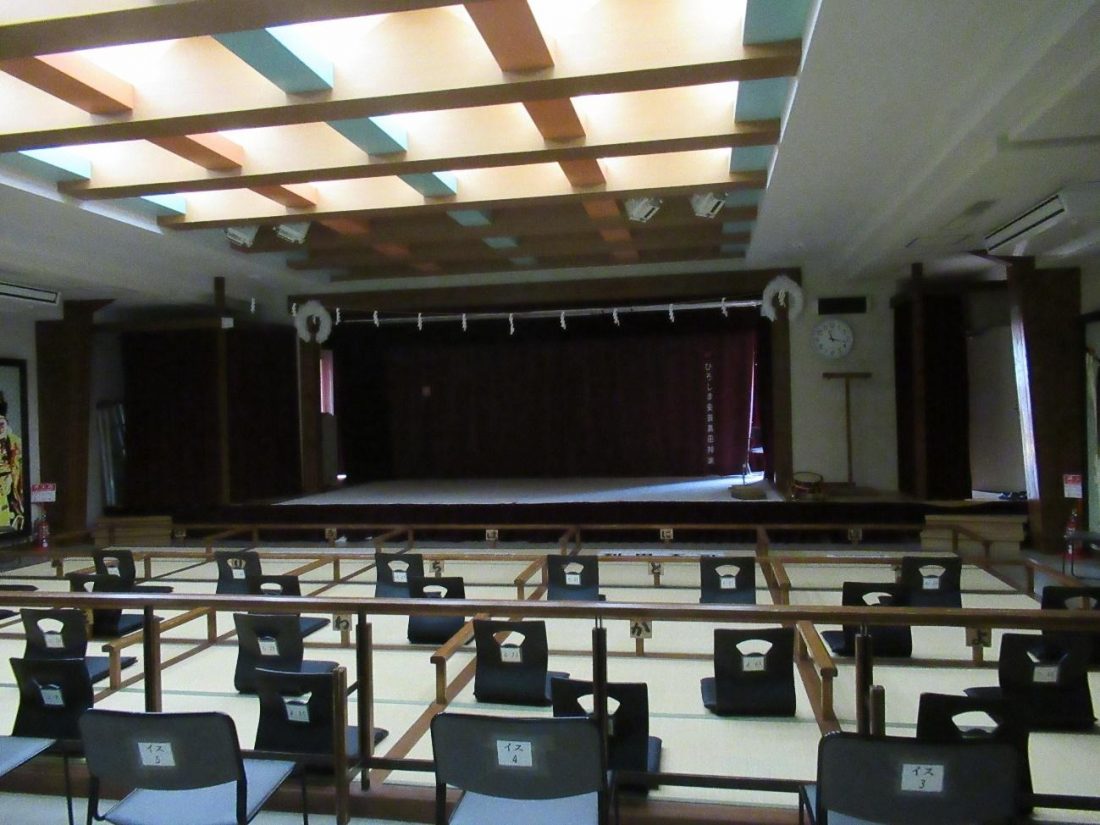
It wasn’t yet noon but my tummy was already growling, so I stopped by the traditional restaurant Fukusuke for some rustic gourmet fare. The restaurant interior is as old-fashioned as the exterior; guests remove their shoes before entering and sit on floor cushions at low tables, as opposed to chairs at high tables. They sell things such as made-in-house tofu, noodles, sushi, tempura made with vegetables of the day, and a variety of meats, including beef, chicken, horse, and even wild game! I got their “Woodland Blessings Set Meal,” which came with cuts of chicken, venison, and wild boar that I would grill myself, the aforementioned fresh veggie tempura (with soy sauce for dipping), their locally renowned tofu, vegetarian sashimi made from konjac, a sweet mustard dipping sauce for the konjac sashimi, nanbanzuke (pickled fried mackerel), tsukemono (Japanese pickles), miso soup, and steamed rice.
Moment of Joy: The Fifth Taste
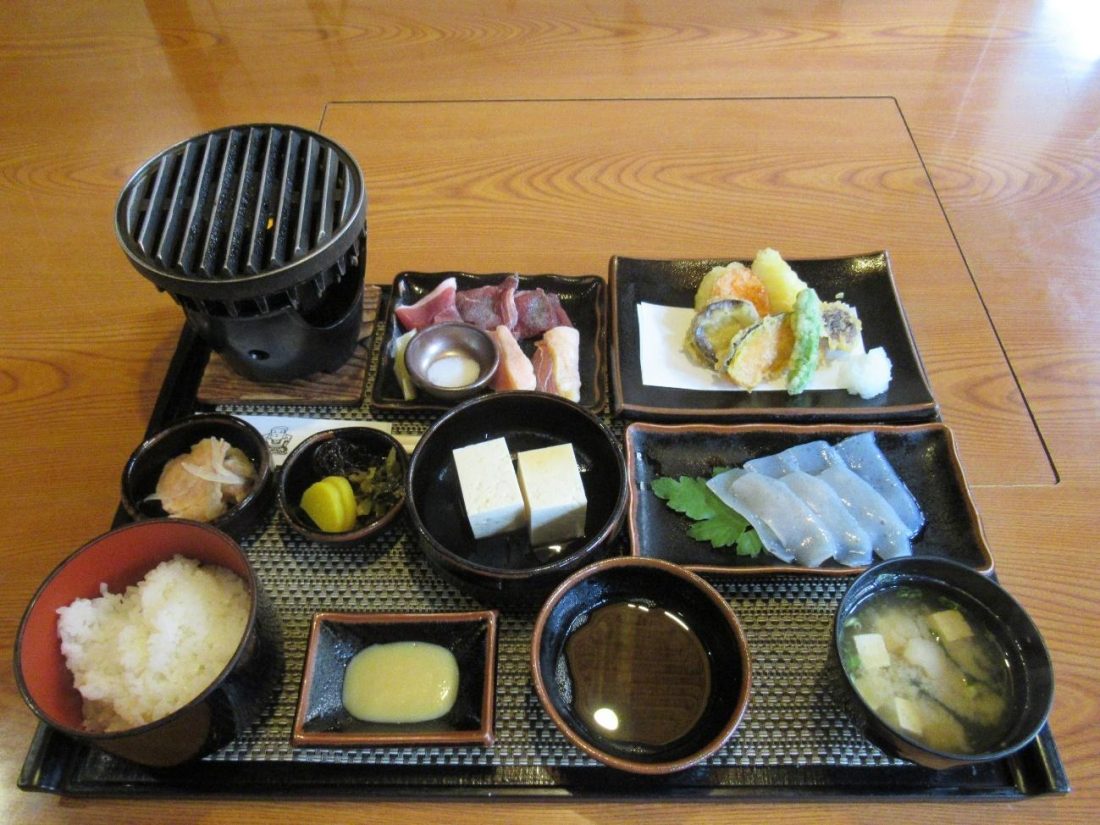
Scientists have identified five basic tastes that arise when eating or drinking: sweet, salty, sour, bitter, and umami, the latter for which there is no English equivalent, but is often translated as “woodsy,” “savory,” “meaty,” or “brothy.” Umami (旨
味) itself being a Japanese word, I have tasted no end of things that I would describe as umami, but there are few things that would describe the taste better than the venison and boar meats I had today. It was the first time I tried deer meat, but I would call it a more tender version of beef, and wild boar was naturally a savorier pork. After grilling them to perfection in a matter of seconds and putting them into my mouth, I felt like I got to know the true meaning of umami, with all the woodsy, smoky, meaty flavors that fit the description.
First Showing
Such flavorful delights had me calling for refills on rice, and by the end of the feast, I was bloated and ready to sit down for some afternoon kagura. I paid and rushed over to the Kagura Dome, which thankfully wasn’t far, flashed my ticket, and picked a tatami seat near the stage where I could sit comfortably with my shoes off. They also had stands and vending machines inside selling snacks, drinks, and souvenirs, but I was too full to want anything, and the show was already starting. This would be the first of two shows today, and one ticket grants admission to both.
Despite being affiliated with the gods, kagura venues are not strict in the slightest when it comes to viewer etiquette. Unlike in Noh, kabuki, or Western theater, kagura viewers won’t be called out for uncouth behaviors such as eating and drinking while watching, getting up, lying down on the tatami mats, sneezing, coughing, belching, yawning, conversing, or even calling out to the performers or musicians. According to Kaguramonzen Tojimura’s English website, “The gods are watching with us…They are our most honored guests, and they generally pay no mind to what we humans do, for they know that we have many flaws.” That being said, all the audience has to do is relax and enjoy the show, and even if you don’t understand a lick of Japanese, kagura can still be fun watch as the music, costumes, and actions speak for themselves. In addition to the cool props the actors wield, the stage is also equipped with simple-yet-effective special effects such as fog flooding the floor and paper streamers falling from the ceiling.
Bathing Intermission
Each play lasts about forty minutes, and since I had about an hour and twenty minutes until the next showing, I decided to stop by the Iwatoya Natural Hot Spring for a quick dip. There are towels available for sale and rental, but you can save money by bringing your own from home or from the hotel where you’re staying. Before entering the bathing facilities, guests first put their shoes in an empty locker and pay a \100 deposit to lock the door. If you don’t have change, buy the ticket from the vending machine first (a single-use ticket for one adult was \700 today) to get some coins. In addition to admission, the vending machine is also where visitors buy tickets for towel rentals or anything else, and upon presenting the tickets and shoe locker key to the staff at the counter, the bathers will be presented with a locker room key and be allowed to proceed to either the men’s or women’s hot springs.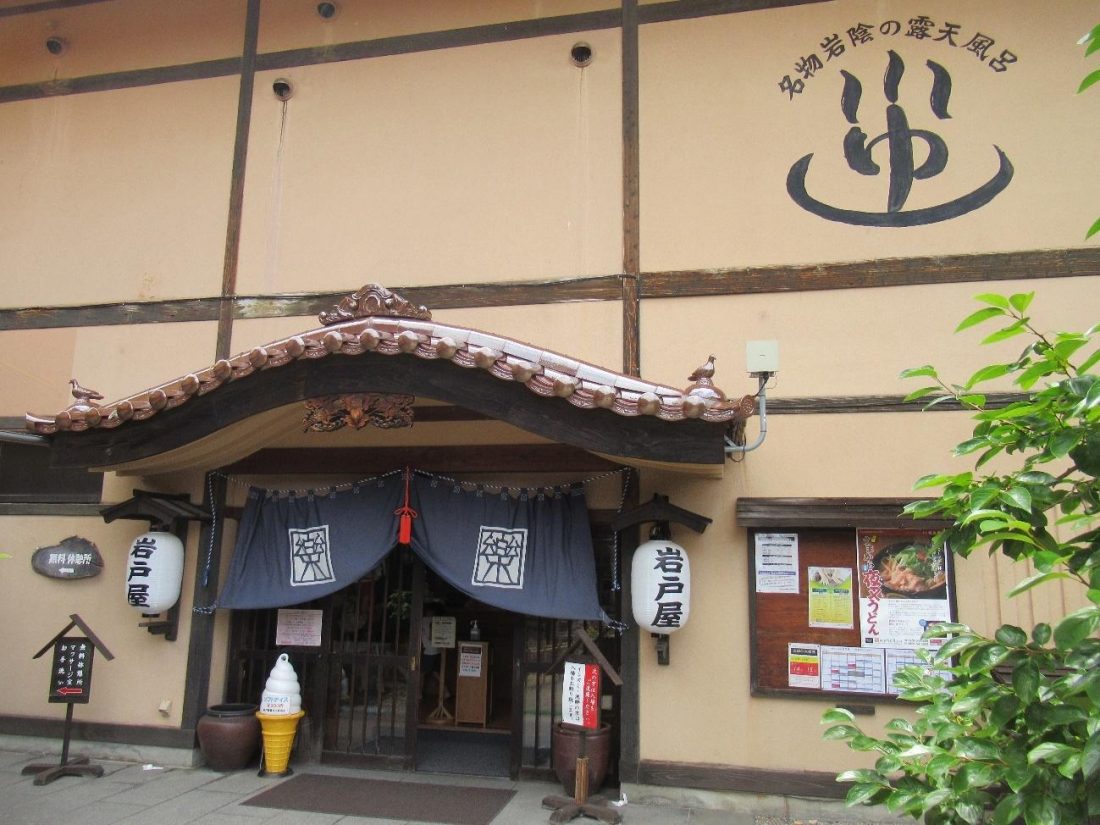
The lockers are spacious, so you can put all your clothes and bags into a single one. You’re going to be butt naked in there, so you really need nothing but your locker key for the baths (you’ll dry up with your towel in the locker room afterwards). Those who rented a small face towel can bring that as it’ll help in wiping off sweat, but DON’T DIP YOUR TOWEL INTO THE WATER! Either leave it at the edge beside you or wear it on your head for safekeeping. Once inside the bathing facilities, be sure to take a shower with the body wash, shampoo, and conditioner so your body is nice and clean before entering any of the baths.
For starters, I took a dip into the hot bath right by the showers. There’s plenty of space, and a wall clock to remind me of how much was time was left before the second kagura performance. A few minutes will do for any of the baths as the water honestly feels like it’s cooking the body, so I got up and went outside to cool off and try the 露天風呂 (ろてんぶろ – rotemburo), or open air baths. The rotemburo lets bathers enjoy the hot water with fresh air, but there’s no need to be shy since there are barriers separating them from bathing facilities for the opposite sex as well as the outside world. Guests will be stepping, sitting and leaning on boulders, so take care when walking inside these natural baths, and take care not to scratch yourself on any of the rocks.
The fun doesn’t stop here either, as back inside, there’s a whole second floor with even more diverse baths. They’ve got a warm, shallow bath that lets visitors lie down like some sort of watery bed, a sauna, an outdoor balcony jacuzzi where guests can turn on the bubbles at their own will, and a cold spring for a change of pace. I tried every one except for the sauna, and saved the cold spring for last, as the sudden drop in temperature opens the body’s pores, helping get rid of yucky stuff on the skin. It’s hard to accustom to the cold water after being submerged in hot water all this time, but once I was sitting comfortably inside the cold spring, I could feel my heart rate decrease and was able to relax more than I did in any of the other baths. Alas, as my fingers were getting prune-like and I could feel showtime inching closer, I got up, showered again, dried my hair and body, put my clothes back on, got all my things together, returned the locker key, got my shoes and \100 back, and rushed back to the Kagura Dome for the second showing.
Sayonara Tojimura
I was a bit tardy for this performance, but running past the admission counter while showing my ticket was a smooth process, and I soon found another tatami seat where I could sit without disturbing the patrons who were already there (or never left between the shows). The plays are based on historical legends, so the same play can be performed by different troupes, and prior knowledge of said legends may aid in the viewer’s understanding. The name of this play was already familiar when I heard it, and sure enough, when the characters came out, I know I had seen it before when I attended a yokagura performance in downtown Hiroshima some years ago. It could’ve been by this troupe or a different one, but despite knowing in general how this story would play out, I was once again amazed by the costumes, musical accompaniment, and intense interpretive dances used to portray mortal combat.
If I had to pay for each showing, I would’ve found it expensive, but two shows for the price of one ticket was a bargain indeed! As soon as the performance ended, people started getting up to leave, and locals who drove here just to watch kagura on a Sunday afternoon made their way to the parking lot. Meanwhile, I still had a good twenty minutes before the next shuttle bus, so I stopped by Kura, a café with a warehouse-like interior, as its name (蔵) suggests. I ordered an ice cream zenzai, a cold, summertime twist on a traditional Japanese dessert, and the waitress went behind the counter and got straight to building my afternoon snack. Zenzai is usually a hot, sweet soup with red beans and rice cakes floating inside, but this ice cream zenzai featured one scoop of green tea ice cream, a small glob of red beans, three freshly boiled rice flour dumplings, a pile of whipped cream with a cherry on top, and one chocolate-lined rolled wafer. Although my lunch was substantial, I was pretty peckish by the end of the kagura performances, so a dessert like this hit the spot and provided a perfect conclusion to my tour of Kaguramonzen Tojimura.
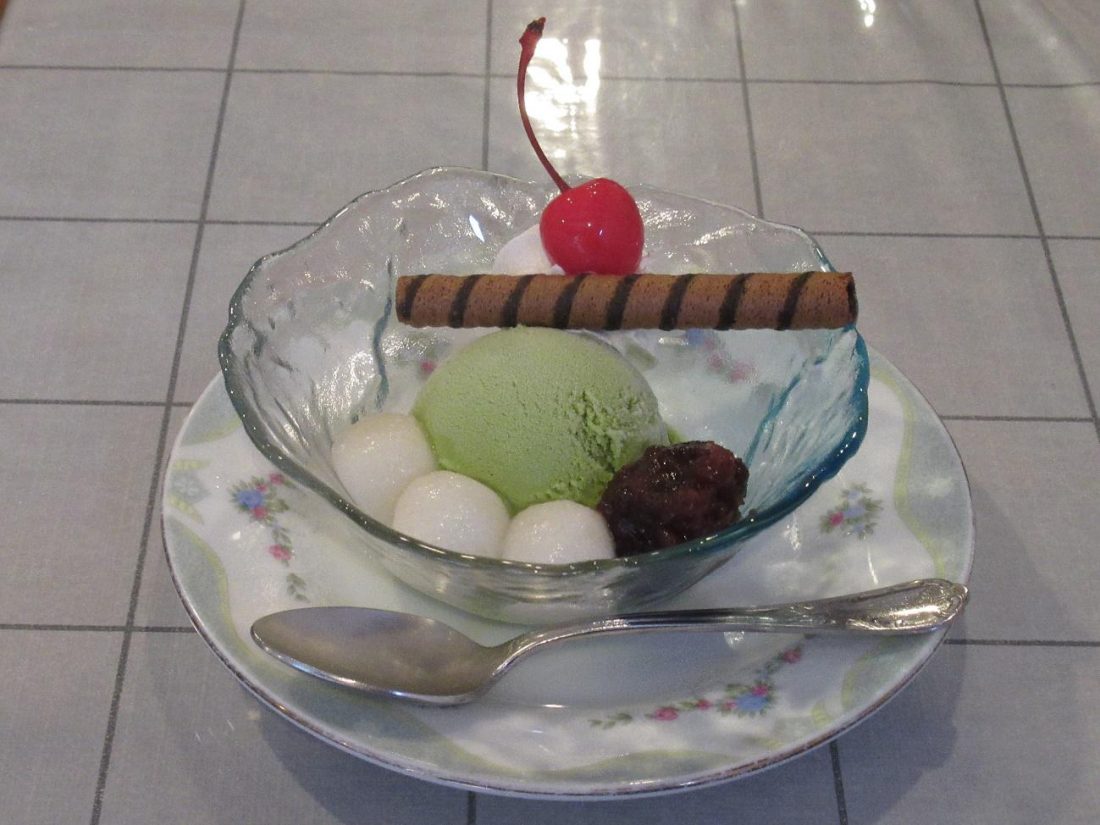
I finished my snack and dashed to the entrance, where the shuttle bus was already waiting. It took me back to the web-encrusted bus stop off the side of the highway, from where I’d take a highway bus back to Hiroshima City. As I needed to head in the opposite direction this time, though, I had to cross the highway to the bus top on the other side. When facing the highway from the shuttle bus stop, turn left until you see a tunnel on your right, then walk through it. After coming out of the tunnel, walk up the incline and make your way past the brush to find a green bus stop, where you can either wait inside or next to the shelter. The timing of the shuttle bus and highway busses is well-aligned, so I didn’t have to wait long for my ride home.
Although Akitakata is located in the mountainous north of Hiroshima Prefecture, this countryside tourist attraction never felt too far away in spite of the two bus rides. I’ll definitely be back again, and to enjoy more kagura, gourmet food, and hot springs, I’d do well to stay overnight on a Saturday. After all, nightlife in Japan takes on numerous forms, and they need not be urban for one to have a blast. If you’re not a city boy or city girl but are still looking for entertainment options in Hiroshima, consider moving your party up north to Akitakata!

